Learn about a memorial that, by honoring a specific group of marines, is bringing healing to all those suffering from the “Silent Battle.”
A startling vision awoke artist Anita Miller, bolting her upright in the middle of the night. The fully formed idea materialized in her mind with an unsettling urgency. She hoped it would be forgotten in the morning light. Instead, it hovered so thickly around her she questioned her mental state.
Two months earlier Miller poured her coffee and settled in to read the local newspaper, her normal morning ritual. That paper’s headline would change the trajectory of countless lives, including hers. The date was August 5, 2005. Fourteen Marines in Lima Company had perished in a devastating roadside bomb attack in Iraq.
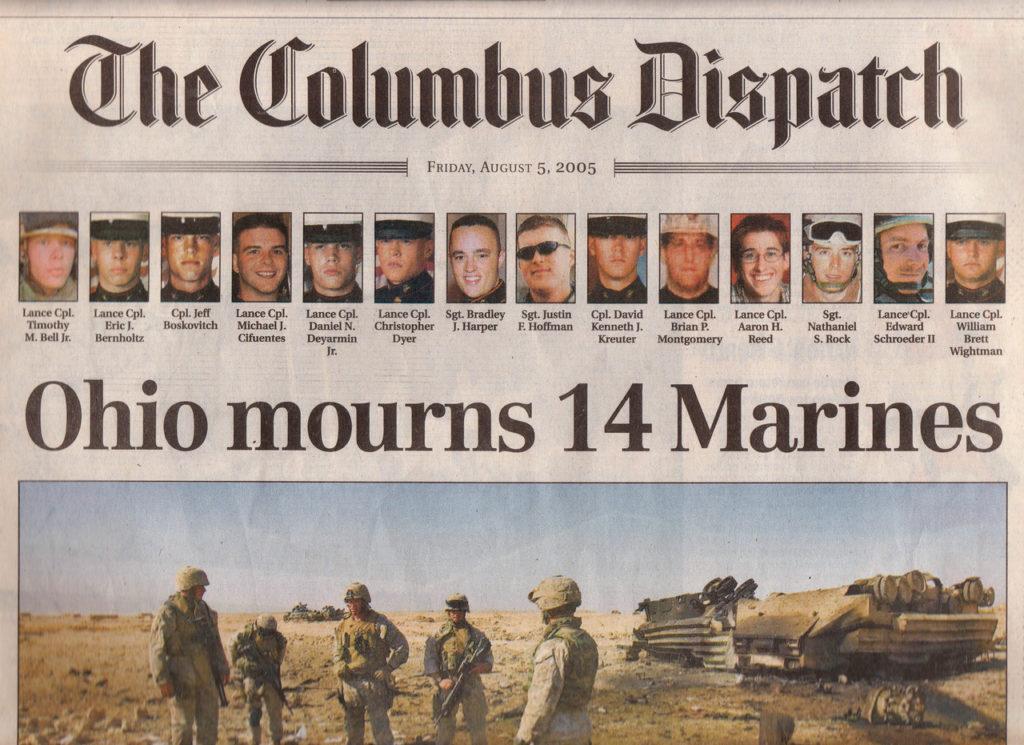
Young men, some married with children, some still in college and one less than a year from high school graduation would never return home. Their families and loved ones’ lives would turn upside down with their loss, unimaginable grief never to be assuaged. A pall hung over Columbus, Ohio that summer, as the deaths mounted of Lima Company. The first died in May; all told, 23 men would be lost. “Lucky Lima,” they had been called. Miller’s sons were the same age, and she could only imagine their family’s pain. She wept along side of thousands of Ohioans although she knew none of the families. She regretted having no way to help.
Two months later, the vision was clear, specific, and unwavering. Miller watched as people walked in and around 8 huge paintings arranged in an octagon, leaving flowers and notes. Life sized portraits of the 23 men of Lima Company created a sacred space, hallowed by their own boots and an ever living candle in front of each portrait. This played out in her mind’s eye in the rotunda of the Ohio Statehouse. In a flash, the image fast forwarded as she witnessed an orderly and efficient takedown, being readied for the next venue. She realized it was a traveling memorial and had the onerous feeling the task was hers to create it.
Miller worked for the next 2 and a half years. With the help of each family, she painted 23 life sized full length portraits. Many of the families would visit the studio, saying they could feel close to their sons there. Miller created a team and together started a not for profit organization that could facilitate exhibiting the work at the Statehouse and its subsequent travel. The powerful memorial at that time was entitled The Lima Company Memorial and was unveiled on Memorial Day of 2008 in the Ohio Statehouse Rotunda, just as the artist had envisioned.
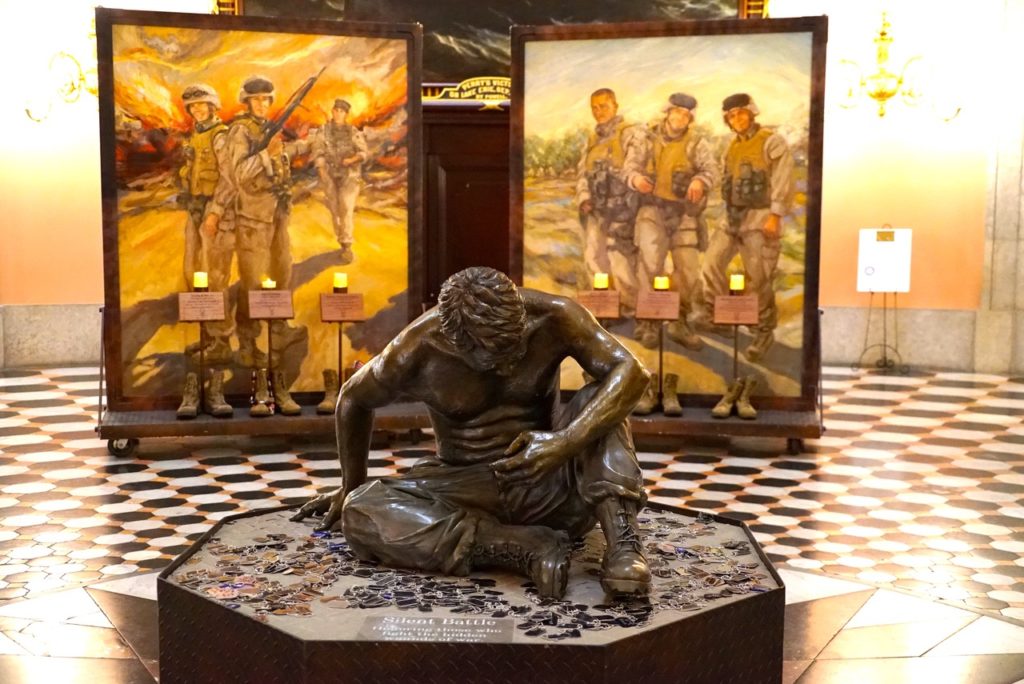
The work stayed on exhibit in the Ohio Statehouse for 6 months and was then requested at the Cincinnati Museum Center at Union Terminal. After that came a request from the National Museum of the Marine Corps. To date, the exhibit has displayed in 32 states at 322 separate events.
“The power of this memorial is due to the gift that they gave,” shares Miller. “Their light shines through the canvas, their love emanates as they reach out in love and comfort. In the circle of the paintings, the veil is thin.”
Originally, Miller felt the memorial served to bring comfort and healing to the families of the fallen men, however, eventually it became apparent this was affecting veterans suffering from survivor guilt and post traumatic stress. Mike Strahle served with Lima Company and was nearly killed in the blast that took several Marines now depicted in the paintings. The young Marine corporal eventually recovered from his injuries and now serves as the full time executive director of the newly named, Eyes of Freedom Traveling Memorial. He credits the memorial with helping in his own healing process.
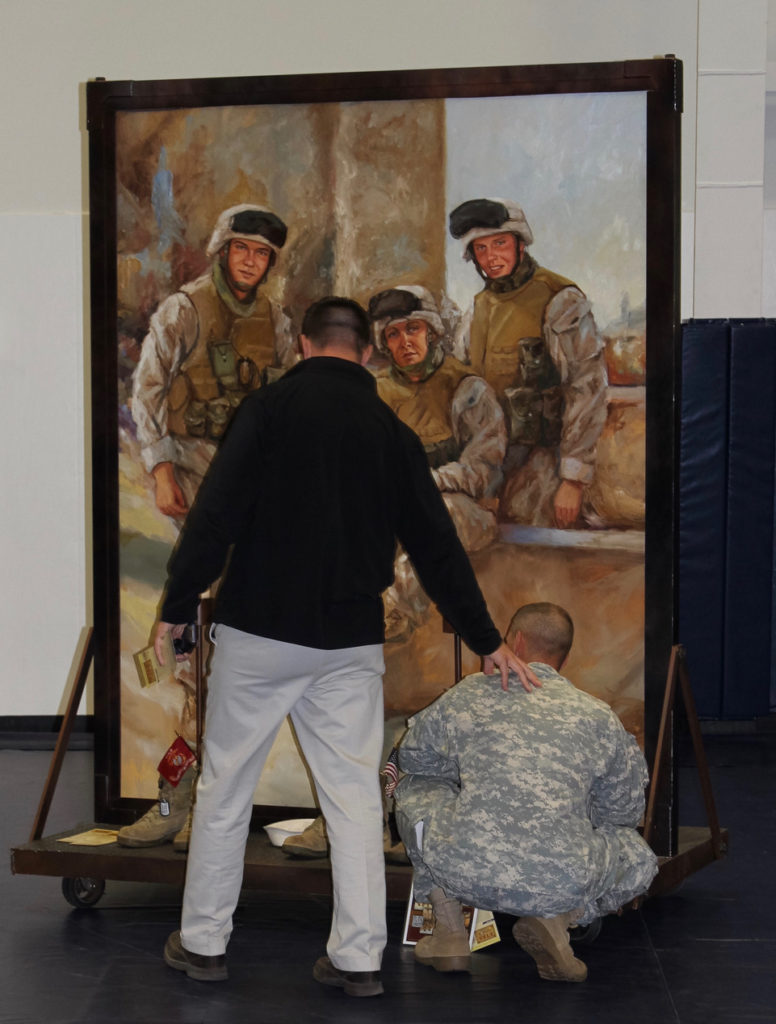
Addressing the Pain of Veterans, and Helping to Heal Them
Strahle and fellow staff member, Sean Flaharty began to see a shift in the demographic of those who were most profoundly affected by the paintings. Suicide issues continued to come up in discussions with the Veterans visiting the memorial. They convinced Miller to add to the exhibit with something that would address the Veteran’s pain. Miller took inspiration from a struggling Army Veteran’s personal account of the event that haunted him the most. Brian Zimmerman shared, “After a devastating mission I saw my friend sitting on the floor holding the dogtags of the men who were killed earlier that day. I still see him sitting there and I can’t erase that memory.”
Miller questioned how that image would help fellow suffering Veterans. He responded, “I guarantee that everyone who sees that will understand and will need no explanation. If a veteran sees that, he will see that he’s not alone. The first step in healing is knowing you aren’t alone.”
Miller created “Silent Battle” just as the soldier described. The life sized bronze now sits prominently in the center of the paintings. Visitors are encouraged to write the names of loved ones who may be suffering or lost the silent battle on blank dogtags and leave them with the sculpture to travel across the country. Visitors are allowed to touch the bronze as they engage with their whole body to the piece.
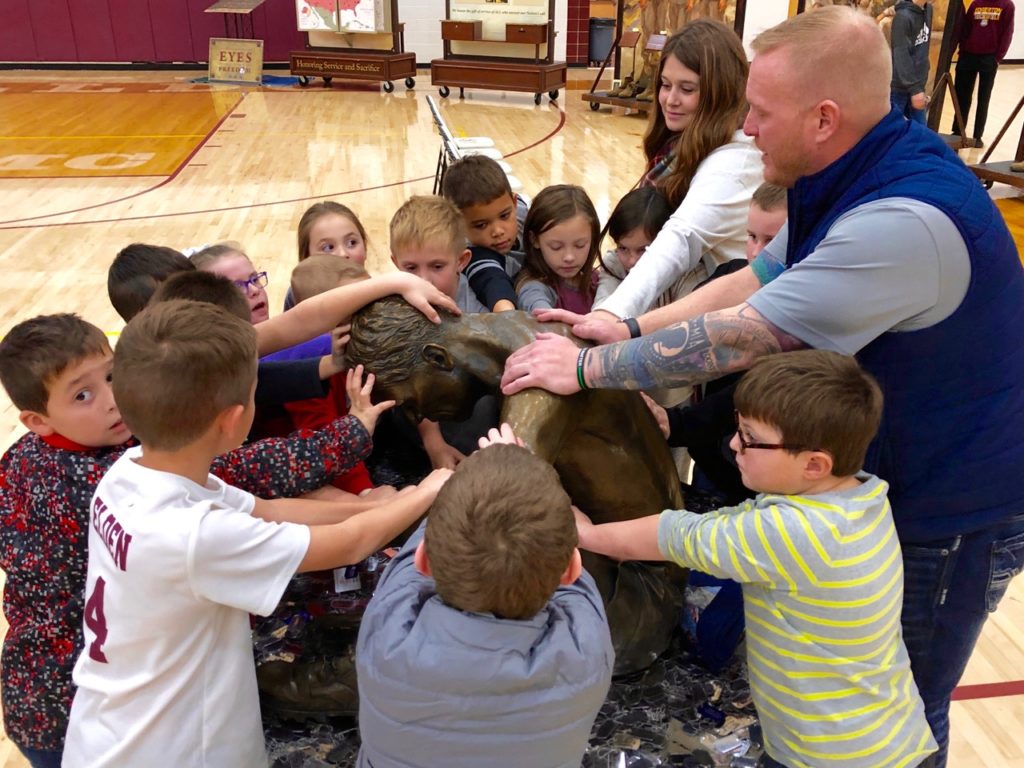
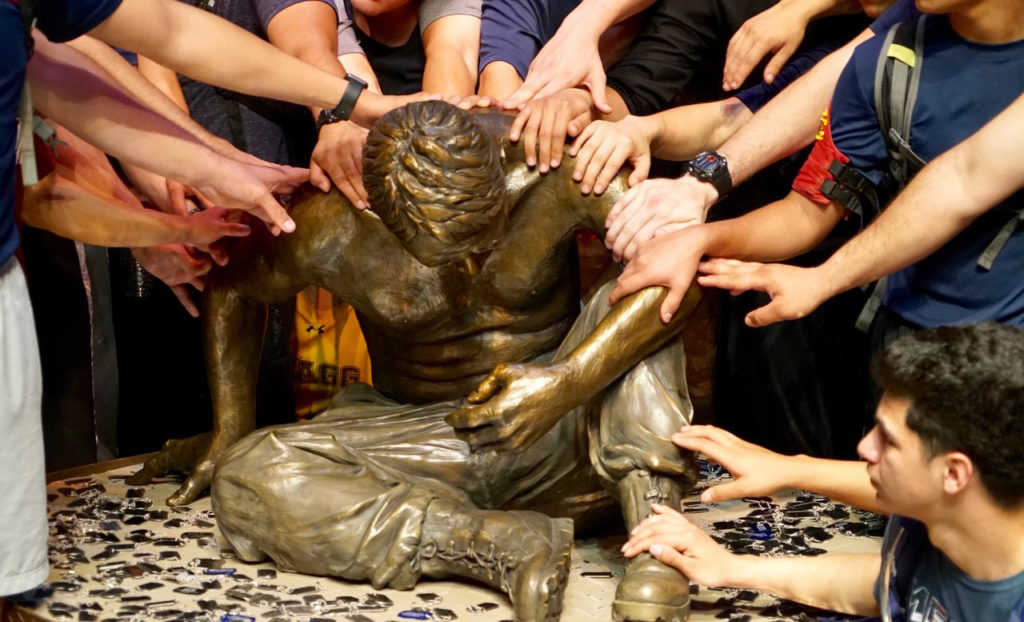
After one such encounter, an Army Veteran shared, “So much shame, guilt, sadness, anger, and regret were laid on those shoulders. From someone who understands the battle and has lost someone to the invisible wounds of war, I feel that every single veteran needs to experience this tribute. It was a safe place to engage in something that many are experiencing, but no one wants to talk about. Interacting with other Veterans fighting the [The Silent Battle] was every bit as impactful as experiencing the bronze sculpture itself. It helped me take a huge step toward healing.
“It was not only what I was able to release on those shoulders, but more importantly what I was able to receive from those shoulders. We are in this together and no one has to fight their battle alone.” ~ US Army Veteran Justin Gallagher, Lafayette Colorado
“There is something truly remarkable and disarming about Anita’s work. I’ve witnessed struggling Veterans engage with the bronze, Silent Battle, and completely shed the layers of DEFENSE being carried like a shell for years. Silent Battle has almost a gravitational pull on both Veterans and Veteran resources, while somehow along the way softening these Veterans enough for them to finally accept the help they need, and they ALL deserve.”
~ US Marine, retired, Mike Strahle, executive director of the Eyes of Freedom
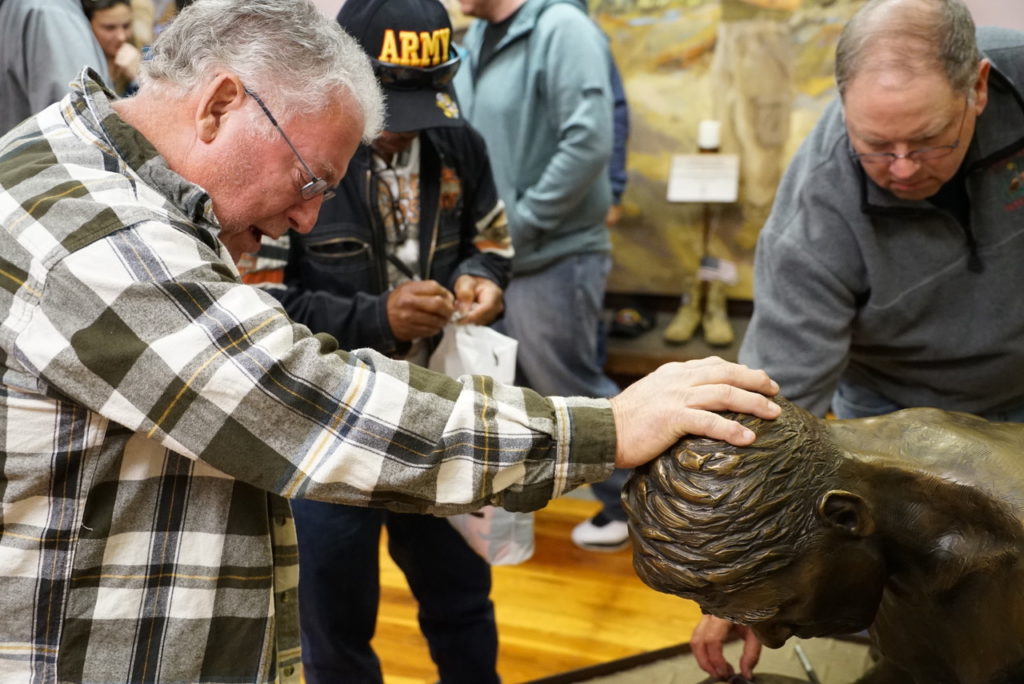
As Covid has grounded the Eyes of Freedom for 2020, we are hoping that 2021 will bring more opportunities for this tribute to continue its healing work. You can read more about the memorial and see if your community would be a good fit for hosting an event at EyesofFreedom.org.
Note for Organizers: The Eyes of Freedom exhibits in a variety of venues, including town festivals, schools, colleges, Veteran’s events, and even prisons across the country. As part of the hosting agreement, the public is never charged to experience the memorial.
> Sign up to receive Fine Art Today, our free weekly e-newsletter
> Click here to subscribe to Fine Art Connoisseur magazine, so you never miss an issue









This is absolutely beautiful Memorial. What is the cost and process to have this at our event every June. Thank you
Hello, Julie! To learn more, please visit their website at https://limacompanymemorial.org/. Best wishes to you and good luck!